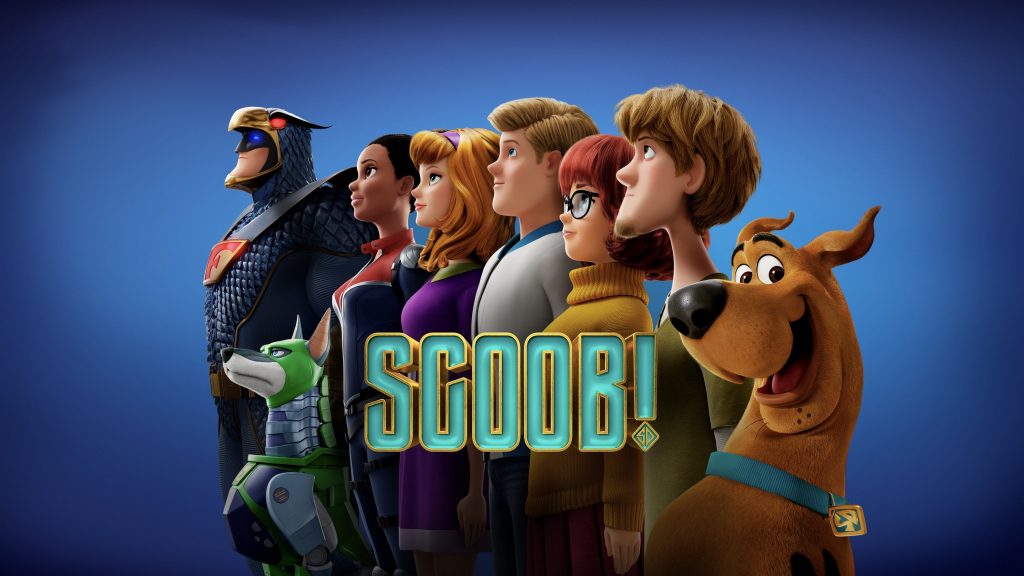
The movie is a steady mix of successful nail-on-the-head hits and derivative fails. We return not to the world of Scooby-Doo, Where Are You? but begin what is clearly the inception of a Hanna-Barbera Cinematic Universe. Scooby’s Laff-a-Lympics with Dastardly and Muttley and The Blue Falcon (Millennials might remember the Scooby-Doo/Dynomutt Hour) At least that god-awful Scrappy-Doo doesn’t show up. In fact, the “mecha-Scooby” Dynomutt and the Falcon Fury are a surprising high point. I would even go so far as to say that Dynomutt, rather than being a goofball, entirely carries this movie despite his limited screen time.
For the short opening segment, we re-hash the back-story where Shaggy meets Scooby, and the pair meet the rest of the gang that will eventually form Mystery, Incorporated. This was already covered, but like every Batman and Spider-Man movie, the writers seem to feel the need to re-introduce timeless myths. The voices of the children who portray the gang as kids are not matched, which pulled me away from the story and felt like watching an old Charlie Brown cartoon.
The most important aspect of a new version of Scooby-Doo, the one that its success really balances on, is the voice acting. Scoob! offers a whole new start, but the loss of the actors that we have come to associate with the characters means we must do the work to re-define them. Frank Welker was Fred from the beginning. Matt Lillard took over Shaggy’s persona after Casey Casem passed on, (which required zero extra work, as Matt is actually the incarnation of Shaggy himself,) Daphne’s voice, Grey Delisle-Griffin (also the voice of Azula in Avatar,) was indistinguishable from the original. Velma’s voice actor has been inconsistent since Mindy Cohn once defined the role. But <em>Scoob!</em> gives us a clean slate with new voices all around.
Shaggy’s voice replacement is terrible– really, truly bad, and though Fred and Daphne, are passable, Velma’s voice and features are so changed here as to barely be the same character but for the orange top and bad bob. (I won’t even mention that unwatchable Daphne and Velma straight-to-video movie.) Luckily, Fred is more of a hero in this rendition than a mystery-obsessed, oblivious van-head, which is how he has been characterized in all the newer series, (Be Cool, Scooby-Doo and Mystery, Inc.) but then, the franchise has never known what to do with Fred. Which is a shame, because he has real potential as a gizmo-minded, tenacious hero. Strangely, they kept Welker as the voice of Scooby. For continuity.
The opening theme montage was amazing. It is true to the original, only now in CGI, and serves to bridge the gap between the gang as kids when they first meet the Great Dane of fame up to their teenage selves.
The cut-out puppetry motif of the animation in certain scenes makes a nice signature look when it works, but when it doesn’t (the bicycle cop in the opening scene) it comes off as a disturbing mix of CGI and live-action base that is reminiscent of the original cartoon Lord of the Rings fiasco. (And I actually liked the puppet version of Scooby-Doo targeted at much younger viewers back in 2013.)
In this story, we go from haunted house mysteries to epic science fiction as the Falcon Fury chases down Dick Dastardly and his minions in their Despicable Me-copter.
One impressive scene where cybernetic scorpions chase Scooby into a house-of-mirrors is poster-worthy, yet followed by an overused joke about Scooby not being able to pronounce ‘R’s, calling “Dick!” Rick. With a lack of any other conflict, the separated Mystery Machine gang look wistfully at pics of Scoob and Shag and miss them terribly, while Shaggy feels left-out when Scooby takes off his collar to join The Blue Falcon team, (a symbol of their friendship, not like, ownership.) Unfortunately, both attempts at emotional empathy miss the mark.
Dick is betrayed by a minion that is a nod to the clones, (even using Star Wars sound effects) in a plot that has something to do with a giant, glowing Phantosaur skull. Dastardly needs Scooby (the descendant of Alexander the Great’s dog,) to open a gate to the Underworld where riches, and a trapped Muttley, await!
A lost world suddenly appears to allow a cameo by Captain Caveman (voiced by that guy from Scare Tactics). The gang is saved by BF (or is he rescued by them?) and his crew, Deedee, (who is pretty much a NPC).
A –designed to not be scary– Cerberus is finally released from the Underworld… wait, how long is this movie? I need popcorn. Son-of-BF becomes courageous after a pep-talk by Dynomutt. Shaggy makes a great sacrifice, but because they couldn’t think of a way to bring him back from the Underworld, a dues-ex-machina statue appears and he comes out. Happy ending. A big dance party to accompany the dabbing memes and Netflix jokes that pepper the entire film …And it keeps going. This was clearly developed as four or five separate story lines jammed into one drawn-out narrative.
You can’t substitute length for characterization revealed through conflict. If they had put the effort into the storyline that they put into the end credits animation and R&B pop-song, they would have had a hit.
